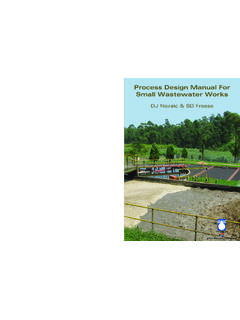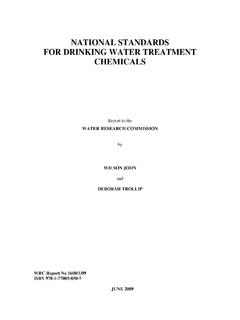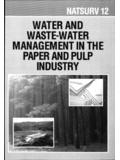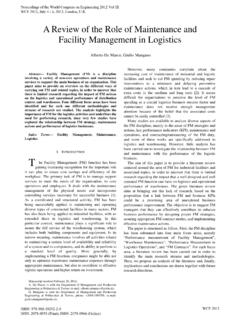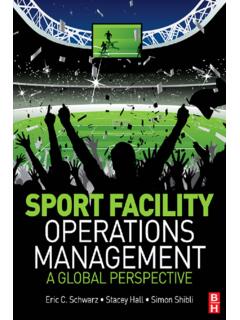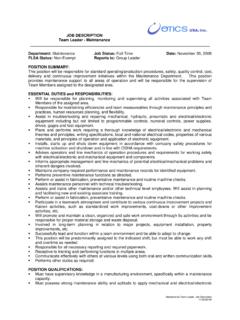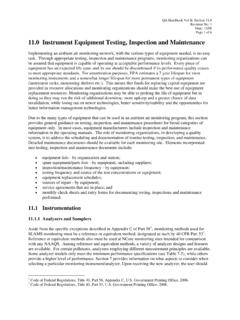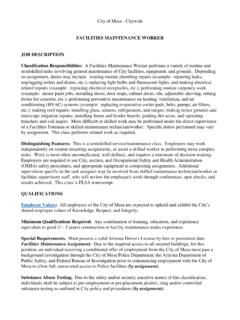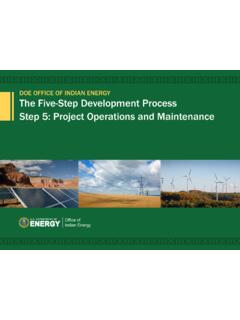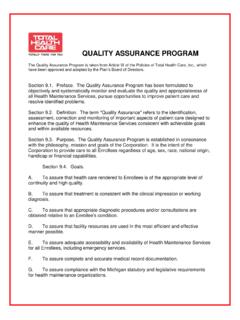Transcription of DESIGN, CONSTRUCTION, OPERATION AND MAINTENANCE …
1 DESIGN, CONSTRUCTION, OPERATION AND MAINTENANCEOFVENTILATED IMPROVED PIT TOILETS IN SOUTH AFRICAR eport to the Water Research CommissionbyJ W Bester and L M AustinCSIR Building and Construction Technology, PretoriaWRC Report No. 709/1/00 ISBN No. 1 86845 647 1 Executive SummaryThis report emanates from the Wsler Research Commission project number K5/709 ersMleo"Preparation of standard engineering drawings, specifications and guidelines for ventilated improvedpit latrines in South Africa".At present. Ventilated Improved Pit (VIP) toilet systems installed in South Africa are constructedaccording to a wide variety of designs and with many different types of materials, with a correspondingdiversity of pertormance level and user acceptability. Some designs are of a good standard, but manytoilets have been installed which do not function properly and are therefore unpleasant to use.
2 Flycontrol is often inadequate and factors such as poor construction, high temperatures and bad odourscan contribute to negative user experience and subsequent perceptions of the systems as second-rateor is generally accepted that the government cannot afford to provide conventional waterborne sanitationto all communities lacking this facility, at least for the foreseeable future. The majority of communitiesare also not in a position to provide or maintain such systems themselves. However, because of thestrong link between sanitation services and public health, it is imperative that a programme whichencourages an adequate basic level of sanitation, which is also largely affordable, be actively pursuedin order to reach the communities who have little or no sanitation it is clear that VIP toilets, correctly designed and constructed, offer an affordable and practicalsanitation option to the majority of rural and peri-urban communities, there remains much ignoranceregarding the proper engineering of VIP toilets.
3 The authorities- responsible for commissioningsanitation programmes, as well as various funding agencies involved in such schemes, do not alwayshave at their disposal the necessary tools to enable them to make informed decisions or choices andconsequently are often'left with a legacy of poorly engineered sanitation systems. Guidelines for thedesign and construction of VIP toilets will assist such organizations in setting acceptable minimumstandards-The original aim of this project was to improve the standard of VIP toilets in South Africa by providingresponsible organizations with the necessary information to enable them to plan, design, construct andmaintain VIP toilets in an effective and sustainable manner. Hence, the following documents wereintended to form part of this project: Research report (this document) Various guideline documents:(a) Design and construction guidelines for domestic VIP toilets(b) Guidelines for local water and sanitation committees on domestic VIP toilets(c) Guidelines for users of domestic VIP , due to the length of time which elapsed, as well as various other eventualities, the guidelinedocuments as stated above have not been completed as part of this project.
4 Guideline (a) has beenreplaced by a document entitled "Building VIPs: Guidelines for the design and construction of domesticVentilated Improved Pit toilets". This document, published and distributed by the Department of WaterAffairs and Forestry, is based largely on the research carried out as part of this project Guideline (b)was eventually considered as being superfluous due to the existence of other documents of a similarnature. An attempt was made to produce Guideline (c), but due to the differing interpretations ofillustrations, etc by various illiterate or semi-literate communities in the country, it was cnncluded thatit would not be feasible to produce a document of this nature which would be applicable is suggested, rather, that each project be evaluated on its merits and suitable posters or otherexplanatory materials produced for the specific communities by involving them in the actual output of this project, as far as the Water Research Commission's original contract with CSIRB uilding and Construction Technology is concerned, is therefore only this research that were identified as being of cardinal importance for community acceptance of ViP toilets areas follows.
5 Design and construction issues social issues environmental and health attention was paid to these aspects during the research phase of the research report includes a brief introduction to personal hygiene, which highlights the healthdangers inherent in human faeces and the importance of using toilets and of washing hands. Thedisease-carrying role of flies is also pointed out. It is further emphasised that three integral factors,which must coexist, are of importance in promoting community health, namely: safe water supplies adequate sanitation facilities correct disposal of operational principles of both VIP and VIDP toilets are discussed in detail, covering importantfactors such as proper ventilation as well as fly and odour control. This is followed by a number ofillustrated examples of VIP toilet designs from Botswana, Zimbabwe, Lesotho, Tanzania and Brazil, aswell as various South African examples.
6 An in-depth discussion of research findings andrecommendations regarding the various components of a VIP toilet is then presented, covering thefollowing aspects: substructure { the pit)- location- capacity- lining- collar pit cover slab- materials- orientation superstructure- location and orientation- materials- door- walls- roof ventilation openings seat or pedestal- types- materials vent pipe- purpose- materials- size and performance- orientation fly screen- purpose- materials- fixing nand-washing attachmentsRegular MAINTENANCE of VIP toilets is essential if they are to continue functioning as they should andremain in an attractive and acceptable condition for use. The research report emphasises cleanlinessand prompt attention to matters such as fixing o) cracks, termite control, stormwaler diversion, flyscreen care, treatment of doors and hinges, as well as mosquito control Factors affecting the rate ofsolids accumulation are listed and attention is drawn to the fact that disinfectants should not be putinto the emptying is often a problem if toilets are not specifically designed to facilitate the process.}
7 Whilemechanical emptying may be 3 solution in some urban areas, it is rarely an option in rural areas, andalso has certain construction , the issue of population density and its implications for choice of sanitation technology isaddressed. The literature yielded certain guidelines on maximum population densities for single pitand twin pit toilets; however, attention is drawn to the problem of progressive loss of ventilation as thenumber of dwellings conclusion it is stated that the Ventilated Improved Pit Toilet, when correctly designed, operatedand maintained, has proved to be an acceptable, cost-effective, hygienic and environmentally friendlysanitation system. While there are always certain disadvantages associated with any sanitationtechnology, if the required attention is paid to all the diverse aspects involved, particularly the socialand cultural aspects, then there is no reason why VIP toilets should not become perfectly acceptableto the vast majority of people who do not presently enjoy the benefits of a well designed andconstructed toiletIt is recommended that the Water Research Commission disseminates these findings to allorganizations involved in the provision of sanitation.
8 It is further recommended that the Commissionactively supports the guideline document for design and construction, of VIP toilets distributed by theDepartment of Water Affairs and Forestry, as these guidelines are a direct outcome of this the course of the research project it became evident that certain aspects of VIP toilettechnology are in need of further research, as the information available was either scanty 01inconclusive. The two most important aspects requiring further investigation areIhe role of enzymes and bacteria in the OPERATION and MAINTENANCE of pits; andthe minimum required depth of intact, unsaturated soil between the pit and thegroundwater in order to prevent steering committee was appointed to assist and guide the work being done on this report, comprismo(he following persons:Dr N P. Mjoli Water Research CommissionMr Chapman Water Research CommissionMr Heier Department of Water Affairs & ForestryMr S.)
9 Hartley Department of Water Affairs & ForestryMr M. Rail Mvula TrustMr J. Harrison Durban Wastewater ManagementMr B. Jackson Development Bank of Southern Nel Department of HealthMr Johannes CSIR Building and Construction TechnologyMr Marats Water Research Commission (committee secretary)The assistance of these persons is acknowledged and research included a number of interviews with persons and organisations involved in the provisionof sanitation facilities, namely:Don Crawford (Institute of Natural Resources) James Rivett-Carnac (Appropriate Technology Information)David Still (Partners in Development CC)Barry Jackson (Development Bank of South Africa)Martin Rail {Mvula Trust) Daniel Carter (Mvula Trust)Isabel Blackett (UNICEF consultant to Department of Water Affairs andForestry)Their cooperation added to the value of the project and this is also project team Austin CSIR Building and Construction Bester CSIR Building and Construction TechnologyA.}
10 Murdoch CSIR Building and Construction TechnologyE. Pascolo CSIR Building and Construction TechnologyThis project was funded by the Water Research of IllustrationsFigure Operational principles of the VIP toilet 6 Figure The Reed Odourless Earth Closet 9 Figure The BOTVIP 10 Figure A schematic diagram of the BOTVIP . 11 Figure The rural VIP toilet in Zimbabwe 12 Figure The rural VIP toilet in Zimbabwe (exploded) 13 Figure Photo of the ferrocement spiral VIP toilet in Zimbabwe 14 Figure Exploded schematic diagram of the ferrocement spiral VIP toilet 15 Figure Photo of the brick spiral VIP toilet in Zimbabwe 16 Figure The brick spiral VIP toilet in Zimbabwe 17 Figure The Blair latrine {One bag model) 18 Figure The Blair latrine (Standard model)}
